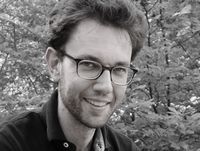Ph Dr. Jonathan Bowden
Project leader

Universität Regensburg
E-mail: jonathan.bowden(at)mathematik.uni-regensburg.de
Homepage: https://sites.google.com/view/jpbowden/
Project
38Geometry of surface homeomorphism groups
Publications within SPP2026
The fine curve graph was introduced as a geometric tool to study the homeomorphisms of surfaces. In this paper we study the Gromov boundary of this space and the local topology near points associated with minimal measurable foliations. We then give several applications including finding explicit elements with positive stable commutator length, and proving a Tits alternative for subgroups of the homemorphism group of a closed surface containing a pseudo-Anosov map, generalizing a result of Hurtado-Xue.
Related project(s):
38Geometry of surface homeomorphism groups
Building on work of Bowden-Hensel-Webb, we study the action of the homeomorphism group of a surface $S$ on the fine curve graph $\mathcal{C}^\dagger(S)$. While the definition of $\mathcal{C}^\dagger(S)$ parallels the classical curve graph for mapping class groups, we show that the dynamics of the action of $\mathrm{Homeo}(S)$ on $\mathcal{C}^\dagger(S)$ is much richer: homeomorphisms induce parabolic isometries in addition to elliptics and hyperbolics, and all positive reals are realized as asymptotic translation lengths.
When the surface $S$ is a torus, we relate the dynamics of the action of a homeomorphism on $\mathcal{C}^\dagger(S)$ to the dynamics of its action on the torus via the classical theory of {\em rotation sets}. We characterize homeomorphisms acting hyperbolically, show asymptotic translation length provides a lower bound for the area of the rotation set, and, while no characterisation purely in terms of rotation sets is possible, we give sufficient conditions for elements to be elliptic or parabolic.
| Journal | Adv. Math |
| Volume | 408 Part B |
| Link to preprint version | |
| Link to published version |
Related project(s):
38Geometry of surface homeomorphism groups
We show that the identity component of the group of diffeomorphisms of a closed oriented surface of positive genus admits many unbounded quasi-morphisms. As a corollary, we also deduce that this group is not uniformly perfect and its fragmentation norm is unbounded, answering a question of Burago--Ivanov--Polterovich. As a key tool we construct a hyperbolic graph on which these groups act, which is the analog of the curve graph for the mapping class group.
| Journal | J. Amer. Math. Soc. |
| Volume | 35 |
| Pages | 211-231 |
| Link to preprint version |
Related project(s):
38Geometry of surface homeomorphism groups

